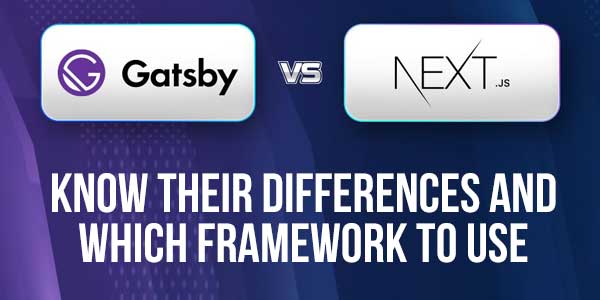
Table of Contents
What Is Next.Js?
Next.js is an open-source framework built on top of React, a JavaScript framework for building applications. Developed by Vercel (previously known as Zeit ), Next.js is designed to simplify the process of building modern web applications by providing functionality so developers can create dynamic web pages.
Next has the following capabilities: Server-side rendering, automatic code splitting, simple client-side routing, built-in support for CSS, Sass, and other solutions.
It also supports client-side rendering as well as server-side rendering. This way developers can create web applications that can render pages on the server for initial loading while fetching data, thus generating fast loading times and improved SEO.
Advantages Of Next:
- Server Side Rendering (SSR): It allows pages to be rendered on the server before being sent to the browser, improving initial load time, SEO, and user experience.
- Static Site Generation (SSG): Enables pre-rendering of pages for fast loading, ideal for sites with static content. Next.js 9.3+ combines SSR and SSG in the same project.
- File-Based Routing: It uses a routing system based on the file structure in the ‘pages’ directory, converting each file into an accessible path.
- Support for API Routes: Allows you to create API endpoints as part of the project, useful for server-side operations or to build an internal API.
- Automatic Optimization: It includes features such as automatic code splitting and optimized image loading, improving overall performance.
- Improved Developer Experience: It offers hot-reloading, reflecting code changes in real-time without reloading the page.
- Customization and Extensibility: It allows you to customize the configuration of Babel and Webpack and supports plugins to extend their capabilities.
- TypeScript Support: It integrates support for TypeScript, allowing developers to take advantage of static typing.
Disadvantages Of Next.js:
- Learning curve: Learning its advanced concepts, such as server-side rendering, can be challenging, especially for new developers.
- Complexity: It adds additional layers of abstraction to React, increasing the complexity of applications.
- Limited Structure: It offers a less flexible structure, which can be a drawback if a highly customizable project structure is required.
- js Environment Required: Requires a Node.js server environment, adding complexity to purely client projects.
- Not Suitable for Static Sites: It may be overkill for projects that only require static sites without server-side rendering capabilities.
- Version Updates: Updates may cause incompatibilities or require refactoring of existing code.
- Server Load: Server-side rendering and API routes can increase the load on the server compared to client-only applications.
- Dependence on a Supplier: Tight integration with its key functionalities leads to vendor lock-in, complicating migration to other frameworks.
- Immature Ecosystem: Compared to React or Angular, Next.js is newer and its ecosystem is still developing.
What Is Gatsby?
On the other hand, we have Gatsby, which is an open-source framework based on React, focused on generating high-performance static websites. It uses React for the user interface and GraphQL for data management, allowing you to easily integrate various content sources. It is also known for its speed, as it pre-builds the site’s pages, resulting in very fast loading times and better performance.
Gatsby can generate static HTML pages at build time, this way the pages load quite quickly. In addition, it stands out for providing a modern web development experience using React and GraphQL, providing sites with excellent performance, security, scalability, and developer experience.
Advantage:
- Incredibly Fast Performance: Create static and optimized HTML pages, resulting in fast loading times, with code and data division.
- Good SEO: Generates SEO-friendly static sites, making it easy to implement advanced SEO techniques.
- React-based: Allows building sites to use React components and hooks.
- GraphQL Data Layer: Provides a unified data layer to integrate different sources and easily query data.
- Huge Accessories Ecosystem: It offers a wide collection of plugins for various functions such as analytics, optimization, accessibility, etc.Res
- ponsive Images: Automate image optimization, tag generation, and lazy loading for responsive images.
- Easy Implementation: Sites can be easily deployed on platforms like Netlify, Vercel, AWS Amplify, etc.
- Progressive Web Applications: PWA features like offline support, manifests, and service workers can be implemented quickly.
- CMS Integrations: Seamless integrations with headless CMS like Contentful, Drupal and WordPress.
- Developer Experience: Hot reloading, APIs, GraphiQL interface and React framework make development easy.
Disadvantages Of Gatsby:
- Generation of Static Sites: It creates only static HTML pages and does not handle dynamic server-side rendering functions.
- GraphQL Learning Curve: It has a learning curve, especially if you are used to REST APIs.
- Complex Development Environment: Requires the installation of multiple dependencies and plugins, increasing complexity.
- Limited Dynamic Content: Handling frequently changing content is difficult, making it ideal only for static sites.
- No Background Code: It does not allow writing application server-side logic or working with databases.
- Limited Customization: The plugin and convention system can limit customization beyond the default structure.Dif
- Difficult Debugging: Debugging build errors on large, complex sites can be complicated.
- Slowest Development Server: Using Webpack may result in a slower hot reload compared to CRA.
- Fragmentation: Fragmentation of plugins in the growing community can lead to a messy ecosystem and inconsistent quality.

Next Js Vs Gatsbty: When To Use Next?
Choosing between Next vs Gatsby is an important decision that depends on the specific needs of your project. Both frameworks are capable of creating modern and efficient applications, but they have key differences that can tip the balance. Here are some situations where Next.js could be the best option for your project:
Using Server Side Rendering (SSR):
Next.js is the ideal choice if you are looking to take advantage of the benefits of SSR. This feature ensures that your apps load quickly and respond in an agile manner, significantly improving user experience and site performance, especially in terms of SEO and loading times.
Development With Modern Javascript:
Next.js is particularly strong at managing JavaScript code. It uses Babel to compile your code, allowing you to use the latest JavaScript features without worrying about cross-browser compatibility issues. This is essential to develop robust applications that are at the forefront of current programming trends.
Next. Js: Usage Examples
Since we have evaluated the strengths and limitations of Next.js, it is useful to examine how this framework is applied in the real world. Leading companies like Netflix, Twitch, and GitHub have implemented Next.js on their platforms, giving us a clear perspective on its practical capabilities. Here are some insights into Next.js use cases:
High Traffic Management:
The adoption of Next.js by high-profile platforms like Netflix and Twitch demonstrates its ability to handle large volumes of traffic. This makes it ideal for applications that need not only scalability but also stability and performance under heavy load conditions.
Building Scalable Applications:
Companies like Github, known for their demanding technical requirements, have chosen Next.js, highlighting its suitability for developing applications that require scalability. Whether for small projects aiming to grow or large enterprise applications, Next.js
Next Js Vs Gatsbty: When To Use Gatsby?
Choosing Gatsby for your web development project can be a wise decision in various situations, especially if you consider the following aspects:
Familiarity With React:
If you already have experience with React, getting started with Gatsby will be a simpler and more direct process. Gatsby is based on React, meaning you can apply your existing knowledge and get up and running quickly.
Variety Of Plugins And Resources:
Gatsby stands out for its vast ecosystem of plugins, offering a wide range of resources that make it easy to add various functionality to your site. This wealth of options can significantly simplify development.
Superior Performance On Smaller Sites:
According to reviews, sites built with Gatsby are perceived to be faster compared to those with Next.js, especially on smaller projects. Although this difference may not be noticeable on sites of moderate size or complexity, on smaller, less complex sites, Gatsby may offer an advantage in terms of speed.
Use Cases For Gatsby:
Gatsby has become popular as a static site generator, ideal for smaller-scale applications such as personal blogs and landing pages. Although it may present challenges for larger websites (e.g., 100k+ pages), there are strategies to optimize Gatsby in these contexts:
- Splitting into Smaller Components: You can split your site into smaller components to better manage complexity and performance.
- Dynamic Imports: Using dynamic imports helps avoid overloading the site, keeping it agile and efficient.
Additionally, the Gatsby plugin ecosystem is constantly growing, offering new ways to extend and improve the functionality of your site. Therefore, although Gatsby is best suited for smaller projects, with proper planning and strategy, it can be an effective solution for larger projects as well.

 About the Author:
About the Author:
















Be the first to write a comment.